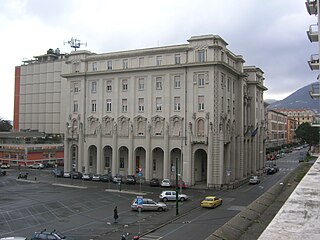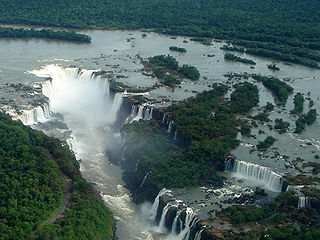
The Italian Riviera or Ligurian Riviera is the narrow coastal strip in Italy which lies between the Ligurian Sea and the mountain chain formed by the Maritime Alps and the Apennines. Longitudinally it extends from the border with France and the French Riviera near Ventimiglia eastwards to Capo Corvo which marks the eastern end of the Gulf of La Spezia and is close to the regional border between Liguria and Tuscany. The Italian Riviera thus includes nearly all of the coastline of Liguria. Historically the "Riviera" extended further to the west, through what is now French territory as far as Marseille.

Ecotourism is a form of nature-oriented tourism intended to contribute to the conservation of the natural environment, generally defined as being minimally impactful, and including providing both contributions to conservation and environmental education. The definition sometimes also includes being financially beneficial to the host community or making conservation financially possible. There are a range of different definitions, and the correct definition of the term was an active subject of debate as of 2009. The term is also used more widely by many organizations offering nature tourism, which do not focus on being beneficial to the environment.

Tourism in Italy is one of the largest economic sectors of the country. With 60 million tourists per year (2023), Italy is the fourth most visited country in international tourism arrivals. According to 2018 estimates by the Bank of Italy, the tourism sector directly generates more than five per cent of the national GDP and represents over six per cent of the employed.

Cultural tourism is a type of tourism in which the visitor's essential motivation is to learn, discover, experience and consume the cultural attractions and products offered by a tourist destination. These attractions and products relate to the intellectual, spiritual, and emotional features of a society that encompasses arts and architecture, historical and cultural heritage, culinary heritage, literature, music, creative industries as well as the living cultures with their lifestyles, value systems, beliefs and traditions.

Te Wāhipounamu is a World Heritage Site in the south west corner of the South Island of New Zealand.

The Cinque Terre are a coastal area within Liguria, in the northwest of Italy. It lies in the west of La Spezia Province, and comprises five villages: Monterosso al Mare, Vernazza, Corniglia, Manarola, and Riomaggiore. The coastline, the five villages, and the surrounding hillsides are all part of the Cinque Terre National Park, a UNESCO World Heritage Site. Vernazza is one of I Borghi più belli d'Italia.

Riomaggiore is a village and comune in the province of La Spezia, situated in a small valley in the Liguria region of Italy. It is the first of the Cinque Terre villages one encounters when travelling north from La Spezia.

The province of La Spezia is a province in the Liguria region of Italy. Its capital is the city of La Spezia.

Porto Venere is a town and comune (municipality) located on the Ligurian coast of Italy in the province of La Spezia. It comprises the three villages of Fezzano, Le Grazie and Porto Venere, and the three islands of Palmaria, Tino and Tinetto. In 1997 Porto Venere and the villages of Cinque Terre were designated by UNESCO as a World Heritage Site.

Deiva Marina is a small Italian comune in the province of La Spezia, located about 65 kilometres (40 mi) east of the city of Genoa on the Riviera di Levante. It is one of I Borghi più belli d'Italia.

Manarola is a small town, a frazione of the comune (municipality) of Riomaggiore, in the province of La Spezia, Liguria, Northern Italy. It is the second-smallest of the famous Cinque Terre towns frequented by tourists, with a population of 353.

Monterosso al Mare is a town and comune in the province of La Spezia, part of the region of Liguria, Northern Italy. It is one of the five villages in Cinque Terre.

Corniglia is a frazione ("hamlet") within the comune of Vernazza in the province of La Spezia, Liguria, northern Italy, with a population of about 150. Unlike the other localities of the Cinque Terre, Corniglia is not directly adjacent to the sea. Instead, it is on the top of a promontory about 100 metres high, surrounded on three sides by vineyards and terraces, the fourth side descends steeply to the sea. To reach Corniglia, it is necessary to climb the Lardarina, a long brick flight of steps composed of 33 flights with 383 steps or, otherwise follow a vehicular road that, from the station, leads to the village. Sometimes a small bus runs.

Vernazza is a town and comune located in the province of La Spezia, Liguria, northwestern Italy. It is one of the five towns that make up the Cinque Terre region. Vernazza is the fourth town heading north, has no car traffic, and remains one of the truest "fishing villages" on the Italian Riviera. It is the only natural port of Cinque Terre and is famous for its elegant houses.

Geotourism is tourism associated with geological attractions and destinations. Geotourism deals with the abiotic natural and built environments. Geotourism was first defined in England by Thomas Alfred Hose in 1995.

Tourism carrying capacity (TCC) is an imperfect but useful approach to managing visitors in vulnerable areas. The TCC concept evolved out of the fields of range, habitat and wildlife management. In these fields, managers attempted to determine the largest population of a particular species that could be supported by a habitat over a long period of time.

La via dell'Amore or The Way of Love is a pedestrian path overlooking the sea, with a length of just over one kilometer, linking the villages of Riomaggiore and Manarola, Cinque Terre, in Liguria, Italy. It is one of four sections of the Sentiero Azzurro, "the Blue Path", the most popular hiking trail in the Cinque Terre National Park.

Manarola railway station is located on the Genoa–Pisa railway, Italy. It serves Manarola, which is one of the five towns of the Cinque Terre.
The Verde Azzurro path, or "Blue trail" is a hiking route that runs entirely within the Cinque Terre National Park, a UNESCO World Heritage Site, primarily connecting the five main villages.























